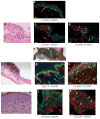Superficial spreading-like melanoma in Arf(-/-)::Tyr-Nras(Q61K)::K14-Kitl mice: keratinocyte Kit ligand expression sufficient to "translocate" melanomas from dermis to epidermis
- PMID: 21307875
- PMCID: PMC3138531
- DOI: 10.1038/jid.2011.21
Superficial spreading-like melanoma in Arf(-/-)::Tyr-Nras(Q61K)::K14-Kitl mice: keratinocyte Kit ligand expression sufficient to "translocate" melanomas from dermis to epidermis
Conflict of interest statement
HPS is a shareholder and consultant for Molemap, Australia. The other authors state no conflict of interest.
Figures


Similar articles
-
(V600E)Braf::Tyr-CreERT2::K14-Kitl mice do not develop superficial spreading-like melanoma: keratinocyte Kit ligand is insufficient to "translocate" (V600E)Braf-driven melanoma to the epidermis.J Invest Dermatol. 2012 Feb;132(2):488-91. doi: 10.1038/jid.2011.341. Epub 2011 Nov 24. J Invest Dermatol. 2012. PMID: 22113477 No abstract available.
-
ARF functions as a melanoma tumor suppressor by inducing p53-independent senescence.Proc Natl Acad Sci U S A. 2007 Jun 26;104(26):10968-73. doi: 10.1073/pnas.0611638104. Epub 2007 Jun 19. Proc Natl Acad Sci U S A. 2007. PMID: 17576930 Free PMC article.
-
Oncogene-induced senescence does not require the p16(INK4a) or p14ARF melanoma tumor suppressors.J Invest Dermatol. 2009 Aug;129(8):1983-91. doi: 10.1038/jid.2009.5. Epub 2009 Feb 12. J Invest Dermatol. 2009. PMID: 19212341
-
The role of Kit-ligand in melanocyte development and epidermal homeostasis.Pigment Cell Res. 2003 Jun;16(3):287-96. doi: 10.1034/j.1600-0749.2003.00055.x. Pigment Cell Res. 2003. PMID: 12753403 Review.
-
Normal human melanocyte homeostasis as a paradigm for understanding melanoma.J Investig Dermatol Symp Proc. 2005 Nov;10(2):153-63. doi: 10.1111/j.1087-0024.2005.200407.x. J Investig Dermatol Symp Proc. 2005. PMID: 16358819 Review.
Cited by
-
Blinded by the light: why the treatment of metastatic melanoma has created a new paradigm for the management of cancer.Ther Adv Med Oncol. 2015 Mar;7(2):107-21. doi: 10.1177/1758834014566619. Ther Adv Med Oncol. 2015. PMID: 25755683 Free PMC article. Review.
-
A melanin-independent interaction between Mc1r and Met signaling pathways is required for HGF-dependent melanoma.Int J Cancer. 2015 Feb 15;136(4):752-60. doi: 10.1002/ijc.29050. Epub 2014 Jul 7. Int J Cancer. 2015. PMID: 24975581 Free PMC article.
-
Modeling melanoblast development.Cell Mol Life Sci. 2013 Mar;70(6):1067-79. doi: 10.1007/s00018-012-1112-4. Epub 2012 Aug 23. Cell Mol Life Sci. 2013. PMID: 22915137 Free PMC article. Review.
References
-
- Abdel-Daim M, Funasaka Y, Komoto M, et al. Pharmacogenomics of metabotropic glutamate receptor subtype 1 and in vivo malignant melanoma formation. J Dermatol. 2010;37:635–46. - PubMed
-
- Dhomen N, Reis-Filho JS, da Rocha Dias S, et al. Oncogenic Braf induces melanocyte senescence and melanoma in mice. Cancer Cell. 2009;15:294–303. - PubMed
-
- Ferguson B, Muller HK, Handoko HY, et al. Differential roles of the pRb and Arf/p53 pathways in murine naevus and melanoma genesis. Pigment Cell Melanoma Res. 2010;23:771–80. - PubMed
Publication types
MeSH terms
Substances
Grants and funding
LinkOut - more resources
Full Text Sources
Medical
Molecular Biology Databases
Miscellaneous

